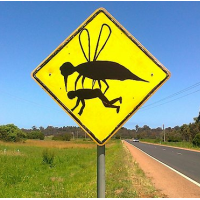West Nile Has Killed Record Number of Californians

Although fewer people have contracted West Nile virus in California this year than last, the state has already set a record for deaths.
According to new data from the state, there have been 32 deaths from 512 cases of West Nile in 30 counties. There were 31 deaths all of last year and 642 cases reported last year at this time. Last year’s death count had been the highest recorded since West Nile turned up in the state in 2003 and the California Department of Public Health (CDPH) began keeping track of it.
Humans and animals get West Nile from mosquito bites. Most people who get the virus don’t get too sick. But 1% can develop a serious neurological illness, like encephalitis or meningitis. People over 50, diabetics and high-blood pressure sufferers are most at risk of serious complications. The average age of those who died last year was 75.
The number of incidents and severity has risen dramatically since the state’s four-year drought began. In 2009, there 112 cases reported and just four fatalities. By 2012, it reached 479 incidents and 20 deaths and then eased a bit in 2013 to 379 and 15.
A report (pdf) by UCLA researchers in February predicted that climate change would dramatically increase West Nile in the state. “In California, we estimate approximately 68% of the state's area will have an increase in the probability of West Nile virus by 2050,” co-author Ryan Harrigan, of UCLA’s Center for Tropical Research and Institute of the Environment and Sustainability, said.
The virus is also responsible for 1,254 reported dead birds in 37 counties. Although the count of dead birds is probably less reliable than dead humans, it has tailed off since its peak was reported in 2004.
The number of dead birds found with the virus isn’t necessarily the measure of the toll on bird populations. A new study from a multi-university group of researchers, including UCLA, found that West Nile is killing millions of more birds than once thought. They found that nearly half the 49 species of birds they studied were impacted by the virus.
“We looked at bird populations in the years before and after West Nile arrived in their habitats, and after the disease arrived you have this massive drop-off in so many of these species,” according to Harrigan, who also co-authored this study. “Seeing these massive effects in species with large, healthy populations is really alarming for smaller populations, which can’t rebound like a large population can.”
The study showed that a West Nile outbreak could have long-term effects, contrary to previous studies. About half of the affected species rebounded in a year, but the other half suffered for the length of the study.
Twenty-nine percent of the 130 million red-eyed virios in the United States died in a single year from West Nile. That population bounced back the next year. But when 9% of warbling virios were killed in one year, their survival rates stayed low.
That bodes ill for bird species hit with West Nile, but sends a larger measure for other living things.
“With climate change and globalization, this isn’t the only newly introduced disease that birds or humans will have to face,” Harrigan said.
–Ken Broder
To Learn More:
California Reports Record Number of West Nile Virus Deaths (by Susan Abram, Los Angeles Daily News)
West Nile Virus Killing Millions More Birds Than Previously Thought, UCLA Researchers Find (by Alison Hewitt, UCLA Newsroom)
Record Number of West Nile Deaths in 2014 Linked to Climate Change (by Ken Broder, AllGov California)
Latest West Nile Virus Activity in California (Fight the Bite)
Persistent Impacts of West Nile Virus on North American Bird Populations (by T. Luke George, Ryan J. Harrigan, Joseph A. LaManna, David F. DeSante, James F. Saracco and Thomas B. Smith, Proceedings of the National Academy of Sciences of the United States of America)
- Top Stories
- Controversies
- Where is the Money Going?
- California and the Nation
- Appointments and Resignations
- Unusual News
- Latest News
- California Forbids U.S. Immigration Agents from Pretending to be Police
- California Lawmakers Urged to Strip “Self-Dealing” Tax Board of Its Duties
- Big Oil’s Grip on California
- Santa Cruz Police See Homeland Security Betrayal in Use of Gang Roundup as Cover for Immigration Raid
- Oil Companies Face Deadline to Stop Polluting California Groundwater





